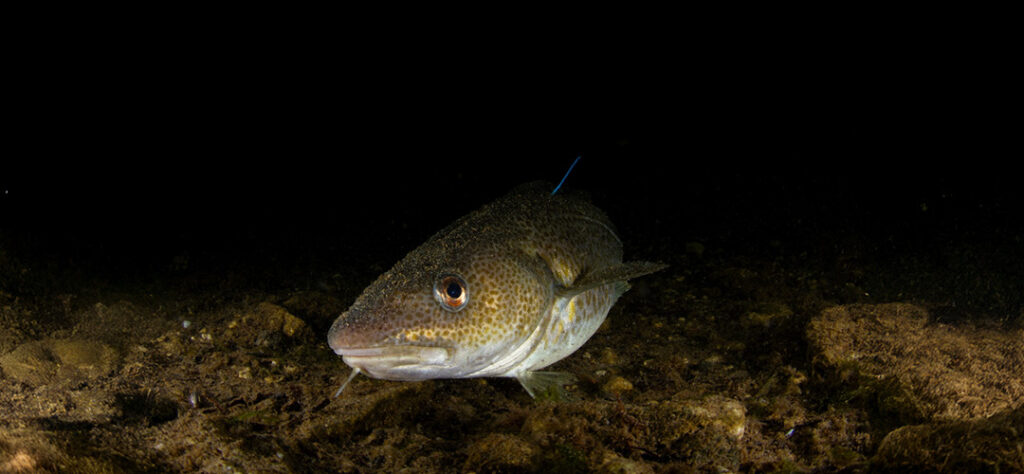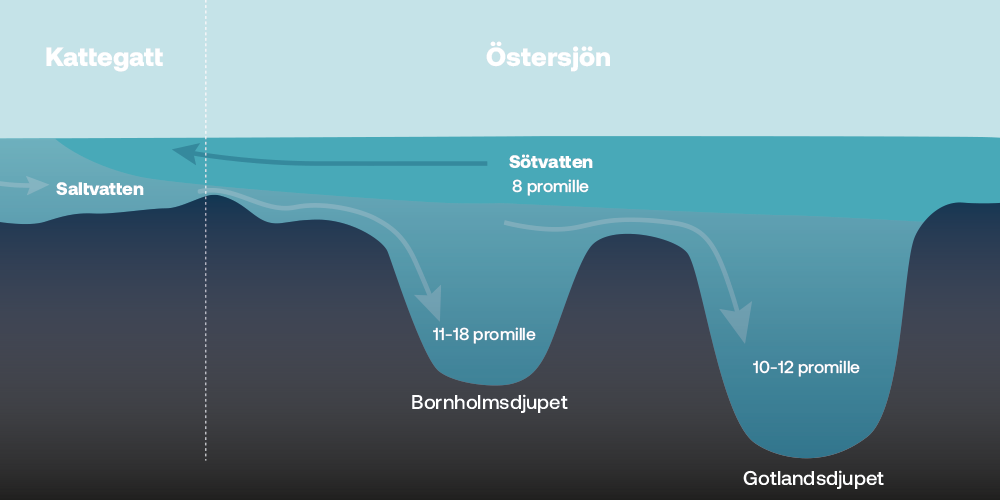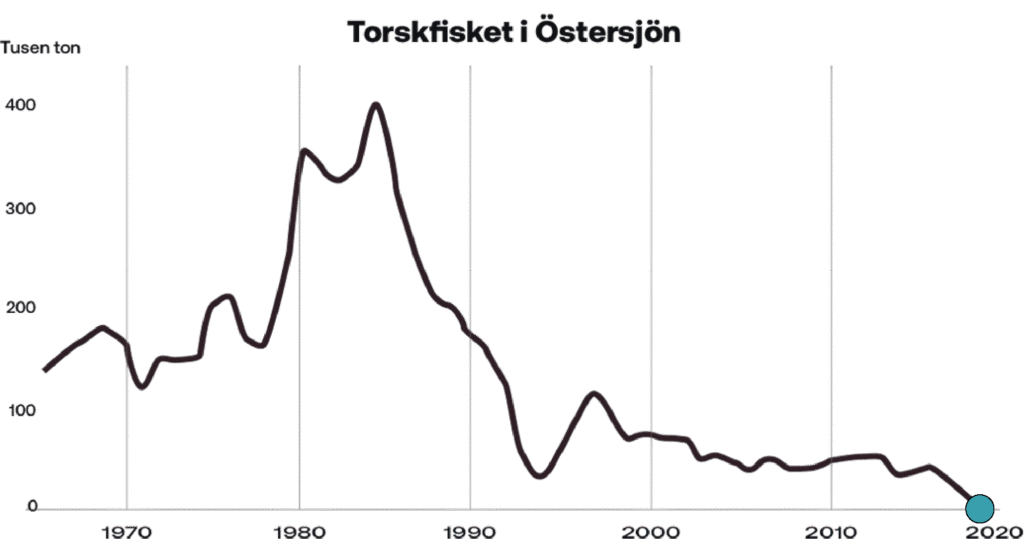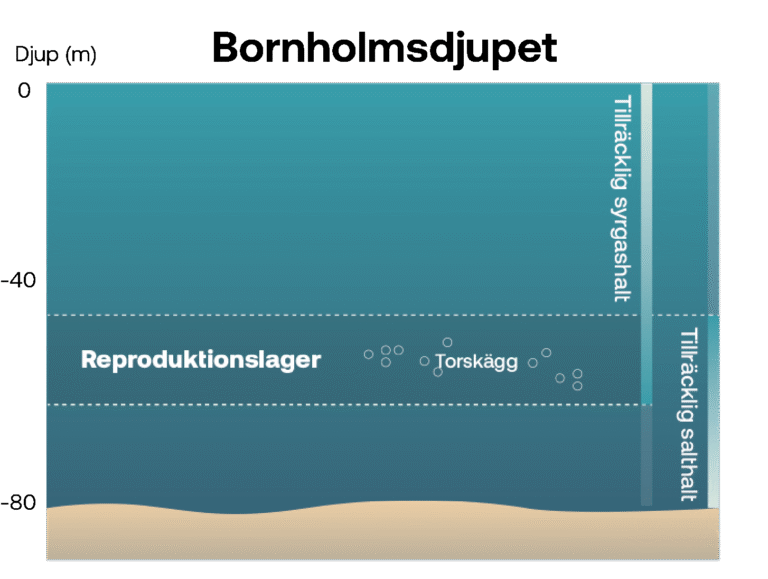Baltic cod
Cod is found in all of Sweden’s surrounding seas and is usually divided into the eastern and western stock. Genetic tools can be used to distinguish three unique stocks – one in the eastern Baltic Sea, another in the western Baltic Sea including Öresund, Kattegat and eastern Skagerrak, and a third in the North Sea including western Skagerrak. Over a long period of time, all cod stocks have undergone evolutionary adaptation to the unique conditions prevailing in their respective sea areas. For example, cod in the eastern Baltic Sea – Baltic cod – has become a genetically unique population that has adapted to the low salinity of the sea.

Baltic cod. Photo: Madeleine Kullenbo
How does the Baltic Sea environment affect the cod?
Salinity
The Baltic Sea is the world’s largest brackish sea and has a relatively low salinity compared to other seas. Fresh water enters the Baltic Sea from land, while salt water enters from the North Sea via the Skagerrak and Kattegat straits. When the salt water manages to cross the high thresholds in the Danish straits, the deep basins of the Baltic Sea are filled with salty and oxygen-rich water. This creates a salinity gradient in depth. But there is also a geographical salinity gradient – moving from the southern to the northern Baltic Sea, the water becomes fresher, and in the Gulf of Bothnia, the water has a salinity of only 2 per mille. Salinity affects life in the Baltic Sea and is a limiting factor for several species, not least cod.

The salinity of the Baltic Sea varies both from north to south and with depth.
Eutrophication
Nutrients are essential for life in the Baltic Sea. Phytoplankton need nutrients (phosphorus and nitrogen) to grow and, in the next stage, they are an important food source for other organisms such as zooplankton. However, when there is too much nitrogen and phosphorus, it can lead to eutrophication. In an eutrophic sea, certain algae can grow unchecked. When large amounts of algae sink to the bottom and decompose, oxygen is consumed, which can lead to oxygen depletion and difficult conditions for both bottom-dwelling animals and cod.
Oxygen-depleted bottoms
Anoxic bottoms are not a new phenomenon in the Baltic Sea, but the spread of seabeds affected by oxygen depletion has increased significantly. Various types of human activities contribute to the outflow of nutrients into the sea. Cod are negatively affected by oxygen depletion both because bottom-dwelling animals that are food for cod disappear and because the conditions for cod reproduction deteriorate as fertilized eggs die at low oxygen levels.
Baltic cod is important for the sea – and for us humans
The role of cod in the sea
Cod have different functions in the ecosystem at different ages and sizes. As fry, cod feed on small zooplankton; it is not until later in life that cod feed on other fish. In this way, cod of different sizes regulate the populations of other species. Cod is a so-called top predator, and when it disappears, it can have major consequences for animal and plant life in the sea.
Cod fishing in the Baltic Sea
For decades, cod has been an important food fish for the countries around the Baltic Sea. Fishing pressure has been intense, and catches of Baltic cod remained between 100,000 and 200,000 tons annually until 1978, before peaking at around 400,000 tons in the mid-1980s. Catches then fell dramatically, and in 2017–2018 the stock collapsed. In 2019, researchers found that the spawning biomass of cod (i.e., the cod that will have grown to maturity and become fishable in a few years) showed no signs of recovery or growth, which led to the quota being set at zero. Since 2019, there has been a fishing ban on the eastern cod stock.

Cod fishing in the Baltic Sea. Catches in thousand tonnes is expressed on y-axis, year is shown on the x-axis.
Since 2022, there has also been a fishing ban on cod in the western stock.
Cod spawning
Baltic cod reach sexual maturity at 2-3 years of age and spawn over a longer period during the year compared to Atlantic cod. Low salt and oxygen levels are limiting factors for successful reproduction. Cod spawning mainly takes place in the deeper areas of the Baltic Sea where the water is saltier. Like many other fish species, cod return to their parents’ spawning grounds when it is time to spawn.
A study of cod spawning in the laboratory shows intricate behavior between the male and female cod before fertilization takes place. The male emits a grunting sound with his swim bladder to attract the female.v
Listen to the grunting sound of cod, recorded by Mathias Andersson, FOI
During the mating dance, the female swims in circles after the male as he attracts her with his sound, and after a while, the female swims up to the surface. The male swims up onto the female’s back and slides down beside her. This ends with the male lying under the female and their bellies pressed tightly together. Fertilization then takes place when the female releases her eggs and the male releases his sperm.
Animation based on Brawn VM, (1961) Reproductive behavior of the cod (Gadus callarias L.). Behavior, Vol. 18, page: 177-198. The cod’s grunting sound was recorded by Mathias Andersson, FOI.
In the open sea, the fertilized eggs and larvae are pelagic, which means that they float freely in the water column. Baltic cod eggs need a certain salinity level to float in the water, otherwise they sink to the bottom and die. For fertilization to be successful and the eggs to develop normally, the water must have a salinity of at least 11 per mille and an oxygen content of no less than 2 ml O2/l. Today, there is only one place left in the Baltic Sea with the oxygen and salinity levels required for cod to continue to reproduce successfully – the Bornholm Deep. Large females produce larger eggs with better buoyancy, and older females produce significantly more eggs than young females. This means that reproductive success is better for older females.

Reproductive success is limited by both salt and oxygen levels. The image shows the so-called reproductive layer (in swedish reproduktionslager), where salt and oxygen levels are at levels that allow the eggs to float and survive. Below the lower limit of the reproductive layer, oxygen levels are too low, and above the reproductive layer, salt levels are too low. Source: Vallin L., Nissling A., (2000) “Maternal effects on egg size and egg buoyancy of Baltic cod, Gadus morhua Implications for stock structure effects recruitment, Fisheries Research 49 21-37.
The fertilized egg floats in the water column and hatches after a few days. The water temperature affects the number of days until hatching. During its first period as a larva, the cod lives on the nutrients found in the yolk sac. The cod then begins to catch its own food, initially mainly zooplankton and later bottom-dwelling animals. It is only when the cod is adult that it begins to eat other fish and, to some extent, crustaceans. In the Baltic Sea, herring and sprat are the most important food sources for adult cod. Adult cod also exhibit cannibalism, meaning that large cod eat small cod. As an adult fish, cod is at the top of the food web and thus plays an important role in the Baltic Sea ecosystem. The absence of cod has a major impact on other parts of the ecosystem.
